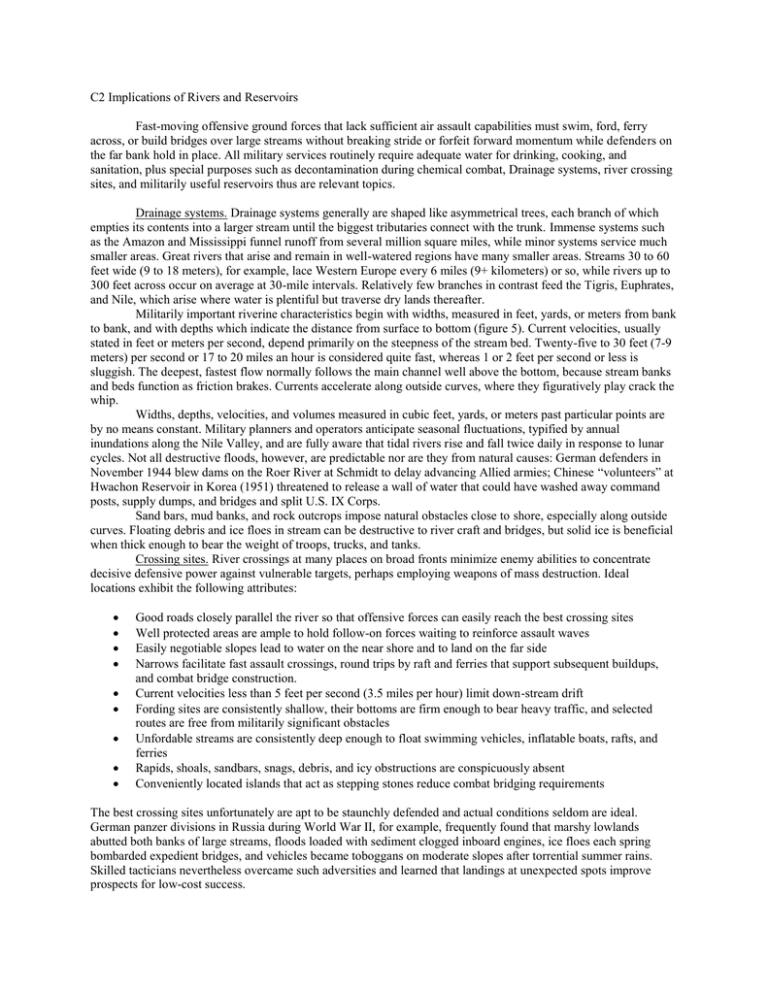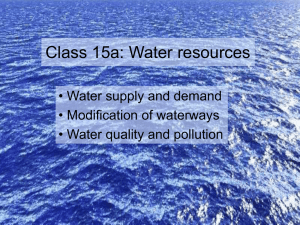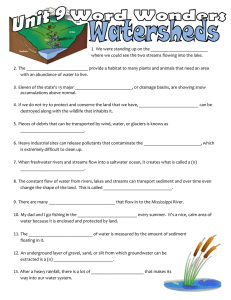C2 Implications of Rivers and Reservoirs
advertisement

C2 Implications of Rivers and Reservoirs Fast-moving offensive ground forces that lack sufficient air assault capabilities must swim, ford, ferry across, or build bridges over large streams without breaking stride or forfeit forward momentum while defenders on the far bank hold in place. All military services routinely require adequate water for drinking, cooking, and sanitation, plus special purposes such as decontamination during chemical combat, Drainage systems, river crossing sites, and militarily useful reservoirs thus are relevant topics. Drainage systems. Drainage systems generally are shaped like asymmetrical trees, each branch of which empties its contents into a larger stream until the biggest tributaries connect with the trunk. Immense systems such as the Amazon and Mississippi funnel runoff from several million square miles, while minor systems service much smaller areas. Great rivers that arise and remain in well-watered regions have many smaller areas. Streams 30 to 60 feet wide (9 to 18 meters), for example, lace Western Europe every 6 miles (9+ kilometers) or so, while rivers up to 300 feet across occur on average at 30-mile intervals. Relatively few branches in contrast feed the Tigris, Euphrates, and Nile, which arise where water is plentiful but traverse dry lands thereafter. Militarily important riverine characteristics begin with widths, measured in feet, yards, or meters from bank to bank, and with depths which indicate the distance from surface to bottom (figure 5). Current velocities, usually stated in feet or meters per second, depend primarily on the steepness of the stream bed. Twenty-five to 30 feet (7-9 meters) per second or 17 to 20 miles an hour is considered quite fast, whereas 1 or 2 feet per second or less is sluggish. The deepest, fastest flow normally follows the main channel well above the bottom, because stream banks and beds function as friction brakes. Currents accelerate along outside curves, where they figuratively play crack the whip. Widths, depths, velocities, and volumes measured in cubic feet, yards, or meters past particular points are by no means constant. Military planners and operators anticipate seasonal fluctuations, typified by annual inundations along the Nile Valley, and are fully aware that tidal rivers rise and fall twice daily in response to lunar cycles. Not all destructive floods, however, are predictable nor are they from natural causes: German defenders in November 1944 blew dams on the Roer River at Schmidt to delay advancing Allied armies; Chinese “volunteers” at Hwachon Reservoir in Korea (1951) threatened to release a wall of water that could have washed away command posts, supply dumps, and bridges and split U.S. IX Corps. Sand bars, mud banks, and rock outcrops impose natural obstacles close to shore, especially along outside curves. Floating debris and ice floes in stream can be destructive to river craft and bridges, but solid ice is beneficial when thick enough to bear the weight of troops, trucks, and tanks. Crossing sites. River crossings at many places on broad fronts minimize enemy abilities to concentrate decisive defensive power against vulnerable targets, perhaps employing weapons of mass destruction. Ideal locations exhibit the following attributes: Good roads closely parallel the river so that offensive forces can easily reach the best crossing sites Well protected areas are ample to hold follow-on forces waiting to reinforce assault waves Easily negotiable slopes lead to water on the near shore and to land on the far side Narrows facilitate fast assault crossings, round trips by raft and ferries that support subsequent buildups, and combat bridge construction. Current velocities less than 5 feet per second (3.5 miles per hour) limit down-stream drift Fording sites are consistently shallow, their bottoms are firm enough to bear heavy traffic, and selected routes are free from militarily significant obstacles Unfordable streams are consistently deep enough to float swimming vehicles, inflatable boats, rafts, and ferries Rapids, shoals, sandbars, snags, debris, and icy obstructions are conspicuously absent Conveniently located islands that act as stepping stones reduce combat bridging requirements The best crossing sites unfortunately are apt to be staunchly defended and actual conditions seldom are ideal. German panzer divisions in Russia during World War II, for example, frequently found that marshy lowlands abutted both banks of large streams, floods loaded with sediment clogged inboard engines, ice floes each spring bombarded expedient bridges, and vehicles became toboggans on moderate slopes after torrential summer rains. Skilled tacticians nevertheless overcame such adversities and learned that landings at unexpected spots improve prospects for low-cost success. Water Supplies. Large armed forces demand enormous quantities of water in peacetime as well as war, whether active or passive, at fixed installations or in the field. Requirements are most difficult to satisfy in arid regions, especially when division-sized ground elements and air wings move frequently. Drinking water must be palatable (color, odor, and taste all count) and be unpolluted by pathogenic bacteria that spread contagious diseases such as typhoid fever, cholera, and amoebic dysentery. Time-consuming and expensive purification processes become obligatory when water for use as coolants is corrosive. Surface and subsurface sources are complimentary, because neither suffices under all conditions. Both contribute supplies that differ quantitatively as well as qualitatively from time-to-time and place-to-place with varying degrees of convenience. Surface water. Rivers, lakes, and some inland seas are large sources of fresh water on Earth’s surface. Lesser repositories include ponds, small streams, and springs. Some sources are consistently reliable, whereas floods and droughts elsewhere seasonably reduce useable water supplies below required amounts. Unpredictable depletions caused by nature or enemy actions may do likewise with little or no notice. Unpredictable depletions caused by nature or enemy actions may do likewise with little or no notice. Prudent commanders consequently try to identify alternative sources before water crises occur. Perennial flows of sweet, cool spring water usually are low in organic impurities but tend to be widely scattered, high in mineral content, and output seldom is enough to satisfy large military formations which most often must establish, operate and maintain water supply points at locations that are easily accessible and facilitate distribution by road. Large quantities of good quality surface water are commonly available on plains and plateaus where rainfall annually exceeds 25 inches (60 centimeters), but ample sources are hard to find in mountains where runoff starts, in frigid climes where sources are ice-bound many months each year, in the tropics where pollution frequently is rampant, and near small towns and urban centers where raw or incompletely treated sewage and toxic chemicals sometimes contaminate running water and reservoirs. Naval vessels and some coastal countries distill brine to produce fresh water. The world’s largest desalinization plant, located in Saudi Arabia, siphons more than 5 million gallons per day from the Persian Gulf (nearly 19 million liters) and, after purification, pipes fresh water as far inland as Riyadh. Allied missile defense batteries took special precautions to protect that facility against Iraqi Scud attacks during Operations Desert Shield and Desert Storm in 1991-1994. The U.S. Marine garrison at Guantanamo Bay, Cuba, which is isolated from the rest of Oriente Province by minefields and other man-made obstacles, routinely requires about 1.2 million gallons (4.5 million liters) of desalinated sea water per month. Surplus capacity and barges, plus 15 million gallons in storage, made it possible to accommodate 55000 Cuban and Haitian refugees who inflated peak consumption to more than 73 million gallons in October 1995 (27.6 million liters). Subsurface Water. Not all precipitation and melt water empties directly into surface drainage systems. A good deal seeps into subterranean reservoirs instead. How much depends on total accumulations, slopes, soil compositions, and the permeability of underlying rocks. Moisture first percolates through an aerated zone that alternately dampens and dries, then reaches the water table, a saturated layer of variable thickness and depths that may be shallow or deep (figure 6). Some water continues to trickle down through cracks and crannies until contained by aquifers encased in nearly impervious rock formations. Artesian springs that rise to the surface under hydrostatic pressures along fissures and fault lines are little affected by seasonal fluctuations or by pollution, but often are too mineralized for human consumption or cooling systems. Relatively slow wells sunk into the water table generally are preferable with two prominent exceptions: well water along littorals tends to be brackish; supplies drawn from arctic sources above permafrost are only briefly productive each year. Mobile ground forces seldom sit still long enough to tap subsurface reservoirs, but ports, airfields, supply depts., major maintenance teams whose humanitarian mission is to improve the quality of life for impoverished people. Subterranean repositories furnish the only reliable source of water inland wherever lands are parched, a fact of particular importance when summer heat heightens routine requirements and demands soar under stressful conditions. Conservative estimates, for example, indicate that it would take approximately 200,000 gallons of wash water to decontaminate the personnel, weapons, equipment, and facilities (such as aid stations and field hospitals) of just one U.S. Army or Marine division hard hit by persistent chemical warfare (CW) agents. That would be a tall order even if fire hydrants were handy, and perhaps impossible in the dessert, where the employment of CW munitions could entail unconscionable risks for both sides if reprisals in kind drenched aggressors. Source: Collins, J. M. (1998). Military geography for professionals and the public. Washington DC: National Defense University.





